With my nephew having several food allergies, I have been wanting to review picture books related to allergies for a while, but when one of my good friends had a traumatic event with her son’s preschool class, I realized I needed to make this post a priority. Allergies can be a difficult concept for children to comprehend, but books can often make this important topic more accessible. For example, children with allergies can often feel like an outsider. When they hear a story and see pictures of a character sharing similar experiences, it can be comforting and uplifting. Books can also teach children without allergies on how to create a safe environment for children with allergies.
In my search for the best picture books related to food allergies, I was initially surprised by how few there are. Luckily several doctors and parents have started writing their own picture books to educate children and caregivers on food allergies. I discovered several excellent books that are aimed at a variety of ages and cover a large spectrum of situations related to food allergies. I hope this list helps comfort and reassure children with allergies and their parents and succeeds in building more awareness around this significant topic.
Thank you to all of the authors and publishers who were willing to send me their books to review to make this post possible. I have donated all of the books provided to me to my local library, so that more people can have access to these great resources.
BEST BOOKS FOR INTRODUCING ALLERGIES
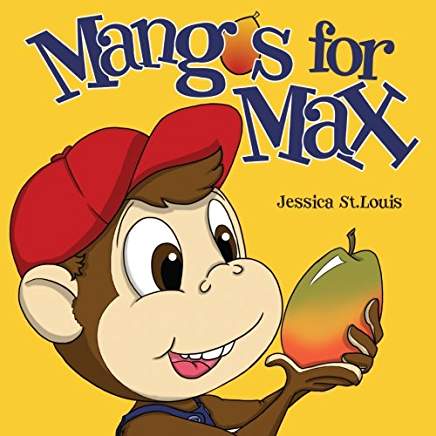 Mangos for Max by Jessica St. Louis; published by CreateSpace Independent Publishing Platform, 2013
Mangos for Max by Jessica St. Louis; published by CreateSpace Independent Publishing Platform, 2013
(Ages 2 – 5)
This short, simple book is a great way to introduce food allergies to toddlers. With bright colors and rhyming text, my two-year-old daughter was drawn in right away to the story of Max, a playful monkey who loves to run, jump, swing from trees, and walk on his hands. When it is time for snack, Max has to be careful of the food he eats because some foods, including bananas, make him sick. He advocates for himself by simply asking to keep the foods he is allergic to away from him. He then enjoys his own snack of mangos. “Food allergies are nothing to dread. He knows what to eat after food labels are read. While his friends eat bananas, Max eats mangos instead.” All of the monkeys are seen smiling and happy throughout the book reassuring children that food allergies don’t have to dampen their fun.
Due to its brevity, flowing rhymes, and colorful illustrations, this is a great book to read to a class of young children to broach the topic of food allergies.
There is a note in the back informing the reader about Food Allergy Research & Education (FARE) and points out that 10% of proceeds will go to furthering food allergy awareness.
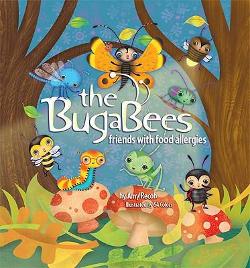 The Bugabees: friends with food allergies by Amy Recob; illustrated by 64 Colors; published by Beaver’s Pond Press, 2009
The Bugabees: friends with food allergies by Amy Recob; illustrated by 64 Colors; published by Beaver’s Pond Press, 2009
(Ages 2 – 5)
Filled with bright colors and a group of smiling bugs (Bugabees), children learn that food allergies can be dangerous, but not detrimental to having fun. Each two-page spread introduces a typical scenario where a child with allergies may encounter an assortment of foods. This includes events such as Halloween, a picnic, school lunch, etc. The rhyming text warns the other bugs, that if one of their friends has an allergy it could make them quite ill. “Treats touched by peanuts will make Cricket sick. She can’t have a bit, not one little lick!” The Bugabees are all seen smiling and the one with an allergy never gets upset that they can’t have the treat. “‘No thank you,’ she says. ‘It’s really okay. I can still have lots of fun without peanuts anyway.’” This refrain is repeated on almost every page by Bugabees with different allergies. The repetition of the chorus gets a little tedious, but drives the message home. Additional activities and talking points about allergies including peanuts, milk, fish, wheat, shellfish, tree nuts, eggs, and soy are provided in the back of the book.
This book succeeds in helping readers understand that allergies do not have to keep children from having fun, but additional visuals would help to make this book even more effective. For example, I wish that the illustrations showed more examples of foods containing some of the top allergens. For instance, my son asked what tree nuts and soy are and I wish there were more pictures of some of the common foods they are in. If I were to read this to a class, I would probably bring in my own larger pictures of foods that could contain the allergens mentioned.
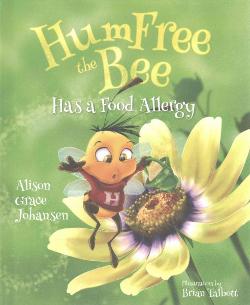 HumFree the Bee Has a Food Allergy by Alison Grace Johansen; illustrated by Brian Talbott; published by Mascot Books, 2015
HumFree the Bee Has a Food Allergy by Alison Grace Johansen; illustrated by Brian Talbott; published by Mascot Books, 2015
(Ages 2 – 6)
This is another great book to use with toddlers or young children to introduce the concept of food allergies. The story is told through rhyming text and bright illustrations that are sure to engage readers. The tale revolves around a young bee named HumFree who becomes sneezy and itchy each time he gets near yellow and blue flowers. His mother explains that he has a food allergy and he has to simply eat the pollen from the other flowers in order to feel good. He avoids the yellow and blue flowers and his friends help him feel safe and included in their activities. HumFree doesn’t let his food allergy bother him and he is as happy as can “bee.”
With additional prompts for discussion and safety tips in the back of this book, it is a good read for a classroom or one-on-one with a child.
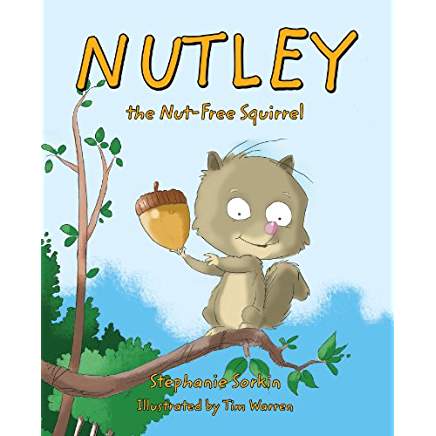 Nutley the Nut-Free Squirrel by Stephanie Sorkin; illustrated by Tim Warren; published by Mascot Books, 2013
Nutley the Nut-Free Squirrel by Stephanie Sorkin; illustrated by Tim Warren; published by Mascot Books, 2013
(Ages 3 – 6)
Nutley is an adorable squirrel who suddenly breaks out into itchy hives after eating a bowl of nuts. He gathers his friends to alert them that he is allergic to nuts and discovers that many of his friends have food allergies as well. They all agree to bring nut-free treats when they play together.
Not much detail is given about what an allergy is and how to treat it once it occurs. The focus is more on educating young children that allergies exist and that a number of people might have them and that is okay. The rhyming text and cartoon-like illustrations make this book accessible to young listeners and provides a nice conversation starter for a more detailed discussion on food allergies. This is a perfect book for young children who may have a food allergy and also a nice read aloud for preschool or kindergarten classes to alert other students of allergies.
The book ends with a nut and egg-free banana bread recipe and a note that points out that all proceeds from the book go toward food allergy research and education.
 My Food Allergies by Amber DeVore, R.D. ; illustrated by David Robinson; published by DNW Publishing, 2014
My Food Allergies by Amber DeVore, R.D. ; illustrated by David Robinson; published by DNW Publishing, 2014
(Ages 3 – 6)
* BEST BOOK TO EDUCATE CHILDREN WITH ALLERGIES
This is the perfect book to give to a child newly diagnosed with a food allergy. It contains several important strategies to teach children and parents how to manage a food allergy. Using short, simple sentences, the author tells the story of how her son, Kieran, was diagnosed with a food allergy after having a reaction to a snack. He was rushed to the hospital where they discovered his nut allergy. This book covers most of the basics including what an allergy is, what some symptoms could be, the importance of checking food labels, not sharing food with friends, and possibly carrying an EpiPen.
In the last few pages, the author addresses the reader and asks if they have a food allergy and what they do to stay safe. The book concludes with a message about being loved and tips on staying healthy.
The amount of information delivered clearly in a kid-friendly manner coupled with the attractive illustrations makes this book a standout among food allergy books.
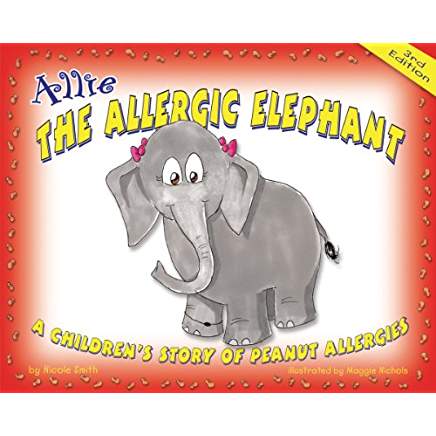 Allie The Allergic Elephant: a children’s story of peanut allergies by Nicole Smith; illustrated by Maggie Nichols; published by Allergic Child Publishing Group, 2000
Allie The Allergic Elephant: a children’s story of peanut allergies by Nicole Smith; illustrated by Maggie Nichols; published by Allergic Child Publishing Group, 2000
(Ages 3 – 7)
This is a wonderful book to teach children about food allergies. It introduces Allie, an elephant allergic to peanuts. The first page points out how special and loved she is, reassuring children with allergies. It goes on to describe how peanuts make Allie itch, swell, and feel terrible. Allie’s friends feel bad for her and want to share their treats with her, so that she will not feel left out. This is a common situation where children unknowingly offer a treat to a child with allergies not understanding the consequences. The author then includes a discussion prompt, “What do you think would happen to Allie if her friends gave her peanuts?” making this a perfect book to use in classrooms to educate students on allergies and their effects.
The book then illustrates a few of the reactions that might occur such as hives, swelling, coughing, etc. One of the strengths of this book is that it shows how children with allergies need to be advocates for themselves by saying, “No thank you” to foods that contain allergens and proactively ask to check the food labels for allergens. The book goes on to describe how peanuts can hide in food and gives examples such as candy bars, ice cream, Chinese food, etc. The book ends on a positive note pointing out other delicious foods Allie can eat and reemphasizes that she is loved and special.
From a content point of view, the brief text does an excellent job of addressing several important issues with allergies. Unfortunately, the artwork is a bit unpolished, which may be off-putting to some adults and children. If parents and children can disregard the unrefined illustrations, however, this is an excellent tool for teaching children about allergies.
 Cody The Allergic Cow by Nicole Smith; illustrated by Maggie Nichols; published by Allergic Child Publishing Group, 2009
Cody The Allergic Cow by Nicole Smith; illustrated by Maggie Nichols; published by Allergic Child Publishing Group, 2009
(Ages 3 – 7)
Cody is a cool cow who loves his family and soccer. He is also allergic to milk. This book focuses on the feelings some children may have when discovering they have an allergy. At first Cody fears he did something wrong that has caused him to be allergic to milk. After all, Cody’s friends and family can drink milk. He then accepts that he was born with the allergy and did nothing to cause it. The book also educates the reader on foods that can hide milk such as ice cream, yogurt, and candy bars. Additionally, the book points out the difference between lactose intolerance and a severe allergy. Cody gets hives, swelling, coughing, and he could even stop breathing. Cody and his family are very careful about the foods that he eats, but his mom still carries an EpiPen everywhere he goes. He is still able to eat other fun foods and he and his parents hope that he will grow out of his allergy one day. There is a note to parents and teacher in the back along with a list of resources.
Similar to Allie The Allergic Elephant this book does a great job of capturing several elements of allergies from the feelings the person with allergies might experience to the act of carrying an EpiPen. Unfortunately, it also contains the same unrefined illustrations. Hopefully adults and children can move past them and embrace these books for the wonderful tools they are!
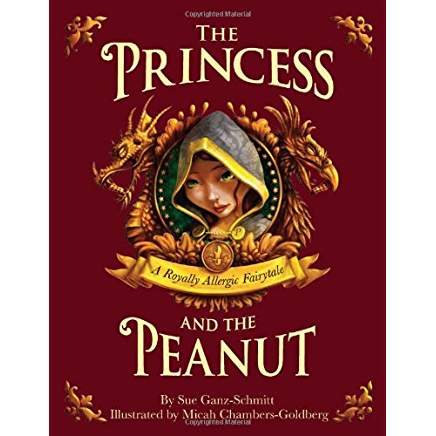 The Princess and the Peanut by Sue Ganz-Schmitt; illustrated by Micah Chambers-Goldberg; published by Wild Indigo, 2011
The Princess and the Peanut by Sue Ganz-Schmitt; illustrated by Micah Chambers-Goldberg; published by Wild Indigo, 2011
(Ages 4 – 8)
* BEST ENTERTAINING AND INFORMATIVE BOOK
Many of the picture books I have read related to food allergies are rather didactic in their nature. This one is a stand out because while it is informative, it is also a fun fractured-fairytale that children are going to love. My five-year-old son particularly enjoyed pouring through the beautiful illustrations of this great retelling of the Princess and the Pea starring a girl with a peanut allergy as the heroine who wins the prince’s heart.
The book begins with a prince in search of the perfect princess, but after scouring the land, he returns home disappointed. When a girl claiming to be a princess shows up on his doorstep, his mother, the queen, is doubtful and demands a peanut be hidden underneath a pile of mattresses to test if she is a real princess. As soon as the girl climbs into bed, she breaks out into terrible hives and her tongue swells. The doctor is summoned and he immediately injects her with an EpiPen then rushes her to the royal hospital. There she has a blood and skin test that reveals she is allergic to peanuts and tree nuts. Convinced she is a real princess, the royal family returns to the castle to read all of the food labels and remove anything that might be dangerous to the girl. She has a moment of self-pity and asks the doctors why she has allergies. I absolutely love the doctor’s response, “Ahh, but princesses are extraordinary, and extraordinary people have great sensitivities.” The king and queen admit their own allergies to cats and dust and the book ends with a royal wedding for a happy ending.
Through the fairy tale, the author effortlessly weaves in the dangers allergies can pose and the potential to have to use an EpiPen or even take a trip to the hospital if there is a reaction. Since the princess has an allergic reaction simply by laying on a bed with a peanut hidden under the mattress, this book can serve as a great conversation starter on how allergens can affect some people simply by touch instead of only ingesting the item. This book is perfect for children with allergies as well as a class read aloud to inform other children about allergies. Entertaining, educational, and a must have for most bookshelves.
BOOKS THAT FOCUS ON KIDS BEING FRUSTRATED OR ANXIOUS
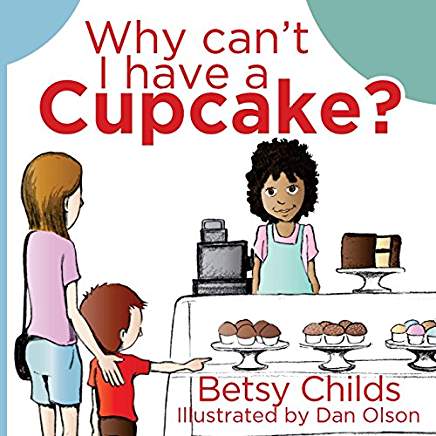 Why Can’t I Have a Cupcake? by Betsy Childs; illustrated by Dan Olson; published by Childpress Books, 2015
Why Can’t I Have a Cupcake? by Betsy Childs; illustrated by Dan Olson; published by Childpress Books, 2015
(Ages 4 – 8)
This is a wonderful story to reassure children with allergies that they can still have fun at social functions and find enjoyment in other delicious foods. Rory is a six-year-old boy who loves birthday parties. Unfortunately, his gluten allergy prevents him from indulging in the birthday cupcakes. At first, he is angry and frustrated by this, but when he sees that other children at the party have allergies as well and have also brought their own snacks, he feels comforted. After the party, his mom takes him to a gluten-free bakery where he can have his very own cupcake.
This book does a good job of reinforcing that children with allergies will become ill if they eat food with an allergen in it, that there are many other children with different types of allergies, and that there is still a lot of food that they can enjoy. The diverse group of children in the book are all very polite and friendly serving as good role models for other children. This is a great book to comfort children with allergies!
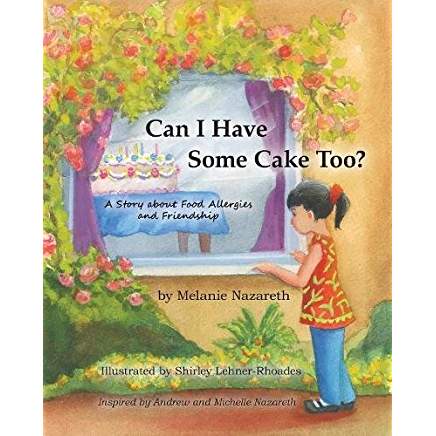 Can I Have Some Cake Too? A story about food allergies and friendship by Melanie Nazareth; illustrated by Shirley Lehner-Rhoades; published by River Sanctuary Publishing, 2013
Can I Have Some Cake Too? A story about food allergies and friendship by Melanie Nazareth; illustrated by Shirley Lehner-Rhoades; published by River Sanctuary Publishing, 2013
(Ages 5 – 10)
Birthday celebrations at school can be very challenging and frustrating to children with allergies. In this story, Michelle spots a beautiful cake on display in her classroom and spends her entire school day thinking about whether or not she can eat it because of her nut-allergy. She knows she should confirm there are no nuts, but part of her just wants to eat the cake. The book presents a very interesting dynamic between two of her friends. The birthday girl, Julia, thinks Michelle should try the cake. She says, “I bet just one tiny piece won’t make you sick. It’s my birthday cake. It’s special.” Her friend, Troy, on the other hand, demonstrates the characteristics of a good friend and encourages her not to eat the cake. He even offers to refrain from the cake as well, so she is not alone. Even as Michelle longingly thinks of eating the cake, she realizes how dangerous it could be. She thinks about the repercussions of breaking out into hives, possibly needing an EpiPen, having to go to the hospital, or even dying. Before the cake is served, Michelle bravely asks the teacher to call her mom, so that she can confirm if there are nuts in the cake. It turns out that the cake is nut-free and Michelle rejoices in her ability to eat an entire slice of cake now that she knows it is safe for her to eat.
This is a great book to read to a child with allergies to reassure them that they are not alone in their struggles and to reinforce the importance of not trying even a bite of something that could potentially contain an allergen. The book could also be a perfect tool to use in the classroom to demonstrate what it looks like to be a good friend to someone who has an allergy. The discussion questions in the back of the book lend itself perfectly for prompting a conversation on food allergies. Due to the amount of text, this book is probably better suited for children age five and older.
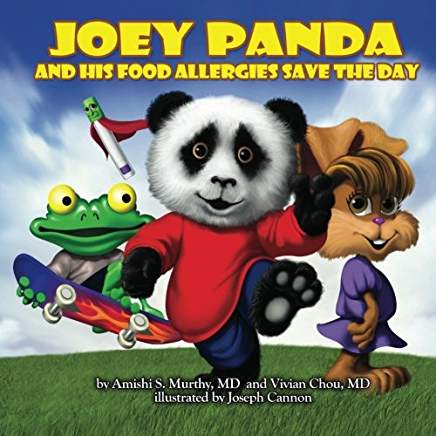 Joey Panda And His Food Allergies Save the Day by Amishi S. Murthy, MD and Vivian Chou, MD; illustrated by Joseph Cannon; published by Chicago Allergist Publications, 2013
Joey Panda And His Food Allergies Save the Day by Amishi S. Murthy, MD and Vivian Chou, MD; illustrated by Joseph Cannon; published by Chicago Allergist Publications, 2013
(Ages 4 – 8)
Joey Panda is preparing to start first grade, but he is nervous the other children will make fun of him due to his large number of allergies. He is allergic to peanuts, tree nuts, eggs, milk, soy, wheat, fish, and shellfish. His mother encourages him to be safe by alerting others of his allergies and to always carry his EpiPen with him at all times. Joey is happy to discover that the children at his school are very friendly and instantly accept him. When Joey notices Kevin Lion’s lips swelling up after eating a cookie, he recognizes the signs of an allergic reaction and immediately finds the nurse. She administers an EpiPen and Kevin feels better. After he rides to the hospital for additional tests, Joey is celebrated as a hero.
This book does a good job of informing children of the dangers allergies can pose and the steps that may need to be taken such as administering an EpiPen or going to the hospital if an allergic reaction occurs. It also teaches children the importance of alerting others of their allergy. There are several examples of Joey warning his teacher and friends of his allergy to ensure his safety. Furthermore, Joey’s EpiPen is represented as an anthropomorphic superhero who hovers around him in almost every scene demonstrating the significance of always carrying an EpiPen. There are a lot of positive elements to this book, but Joey’s anxiety might also make some children nervous themselves. Hopefully by the end of the book, however, they will be reassured that allergies will not affect their friendships or their ability to have fun.
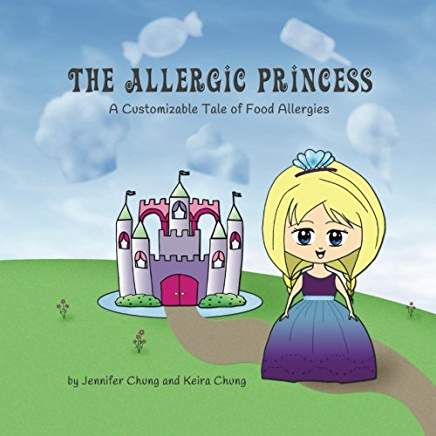 The Allergic Princess: A Customizable Tale of Food Allergies by Jennifer and Keira Chung, published by CreateSpace Independent Publishing Platform, 2016
The Allergic Princess: A Customizable Tale of Food Allergies by Jennifer and Keira Chung, published by CreateSpace Independent Publishing Platform, 2016
(Ages 4 – 8)
This unique story allows readers to fill in their own allergies and symptoms to make it customizable for each child. The plot follows Princess Isabella, a young blonde girl, as she attends a birthday party. Along with her present, Isabella also brings her Epipen in case of an allergic reaction at the party. Excited by the colors, magic show, and delicious looking dessert, Isabella makes a foolish decision and eats a piece of the birthday cake without asking what the ingredients are. She immediately begins to have a reaction. She is injected with her Epipen and her mother brings her to the hospital. Soon after during a playdate, Isabella is offered muffins, and learning from her mistake, politely declines while informing her friends of her allergies. Her mother gives her a reassuring squeeze and Isabella happily eats the safe treat her mother has prepared for her.
It can be difficult to find a book that focuses on each child’s unique allergy. This book encourages readers to write in their own allergies, symptoms, and favorite allergy-free treat allowing children to feel a connection with the character. Children often enjoy seeing a reflection of themselves in books and the fact that they can see a character will their exact symptoms and allergies is reassuring.
The book can also be used as a discussion tool for different strategies to stay safe with an allergy. For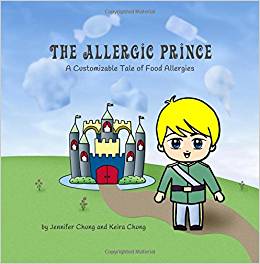 example, it touches on the importance of alerting others to an allergy, developing self-control, calling ahead to find out what is in a special dessert, and packing a safe snack.
example, it touches on the importance of alerting others to an allergy, developing self-control, calling ahead to find out what is in a special dessert, and packing a safe snack.
Don’t worry, there is a version for boys as well! The Allergic Prince: A Customizable Tale of FoodAllergies by Jennifer and Keira Chung, published by CreateSpace Independent Publishing Platform, 2017 is also available.
BOOKS ON ALLERGIES AND FRIENDSHIP
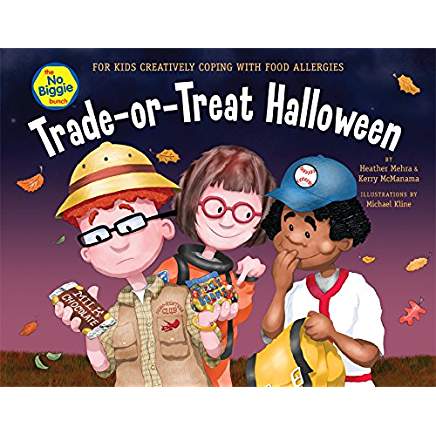 The No Biggie Bunch series by Heather Mehra & Kerry McManama; illustrated by Michael Kline; published by Parent Perks, Inc, 2009
The No Biggie Bunch series by Heather Mehra & Kerry McManama; illustrated by Michael Kline; published by Parent Perks, Inc, 2009
(Ages 3 – 6)
Where many books on food allergies demonstrate children feeling frustrated or restrained by their food allergies, The No Biggie Bunch series takes a different approach. A diverse group of children create fun strategies to celebrate their food allergies instead of feeling limited by them. For example, in Trade-or-Treat Halloween, the group gets excited for candy they collect that contains their allergen because they get to take it home and trade it for another prize or treat that is safe to eat. In Sports-Tastic Birthday Party, the group celebrates Scotty’s birthday with a delicious soy and nut-free cake. Since other members of the group are allergic to the eggs, milk, and gluten in the cake, they happily pull out their own special treats that they brought with them.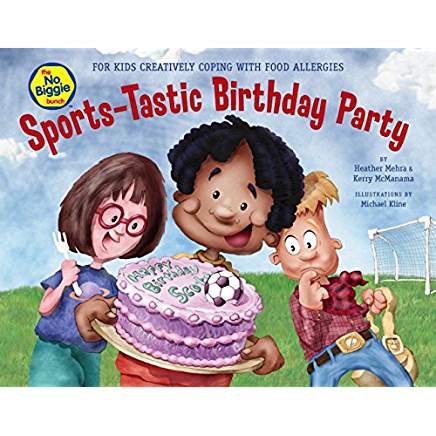
The books do not go into much detail about what an allergy is or the reactions children can have if they
come into contact with an allergen. The focus is more on creating safe and healthy tactics such as bringing an allergy-free snack to eat during social events such as a playdate or birthday party. In each book, the children are seen smiling and don’t seem discouraged in the least by their allergies. With its bright, engaging illustrations and simple optimistic message, The No Biggie Bunch series will hopefully inspire many children to put aside their frustrations and embrace positive strategies to stay safe and still have fun.
 The Peanut-Free Café by Gloria Koster; illustrated by Maryann Cocca-Leffler; published by Albert Whitman & Company, 2006
The Peanut-Free Café by Gloria Koster; illustrated by Maryann Cocca-Leffler; published by Albert Whitman & Company, 2006
(Ages 4 – 8)
Simon is a picky eater and peanut butter is his food of choice. Simon is shocked when he meets a new student, Grant, who is allergic to peanuts. Grant carries his own EpiPen and shares that if he has peanuts or anything made with peanut oil he can’t breathe. He explains that his old school was nut-free and the children at Nutley School, where peanuts are the most popular lunch item, are stunned by this news.
The principal creates a peanut-free table, but no one wants to sit there at first. Then a flyer is sent out announcing the “Peanut-Free Café”, a room where students can do crafts and watch movies while eating lunch. The only admission is a peanut-free lunch. While all the other students are excited to try something new, Simon struggles to give up his favorite food. When the teachers show his favorite movie during lunch, the draw of the café is too much for Simon and he begs his mom to pack him something besides peanut butter. He settles on chili, which becomes a new staple in his diet. While Simon continues to love eating peanut butter over the weekends, he finds a new favorite nut-free lunch during school days.
This book is not necessarily for kids with allergies, but is better suited to teach other children about allergies and the importance of keeping food with allergens away from children with allergies. The diverse group of children are very kind and serve as great role-models by embracing their new friend and changing their diets as to not endanger Grant. The strength of this book is its ability to teach children empathy and encourage them to try something new.
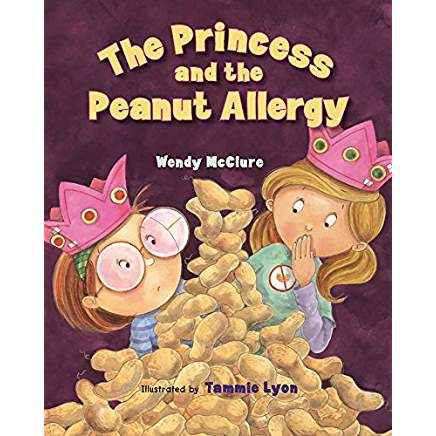 The Princess and the Peanut Allergy by Wendy McClure; illustrated by Tammie Lyon; published by Albert Whitman & Company, 2009
The Princess and the Peanut Allergy by Wendy McClure; illustrated by Tammie Lyon; published by Albert Whitman & Company, 2009
(Ages 4 – 8)
Regina and Paula are best friends. Regina’s birthday party is coming up and both girls can’t wait to play princesses and space dragons. Most of all they are looking forward to Regina’s giant birthday cake. Then disaster strikes. A few days before the party, Paula discovers that Regina’s cake will be made out rocky road nutty fudge and Paula has a peanut allergy. At first Regina can’t understand why Paula can’t just pick out the nuts and blames Paula for ruining her party. Paula’s feelings are hurt and both girls go home from school angry. The next morning Regina wakes up with the revelation that she doesn’t want to hurt her friend and let peanuts ruin her party. She changes the cake to be nut-free, so that everyone can enjoy it. The girls make up and have a marvelous time at the party after all.
This book introduces some of the social nuances that comes with allergies. Birthday parties, Halloween, class snack, etc. are common pit falls for children with allergies. The book demonstrates how important it is for children to speak up and let others know about their allergies. It also brings up the issue of cross contamination, educating children that many kids with allergies cannot eat food that has even touched an allergen.
The book does not go into a lot of detail about the allergy itself. Paula briefly mentions that peanuts caused her to go to the hospital and now she has to carry special medicine with her. The focus is more on the strain allergies can have on a friendship and the happy ending shows that allergies don’t have to stop children from having fun.
A note in the back provides additional information on the importance of educating children, parents, and teachers on food allergies.
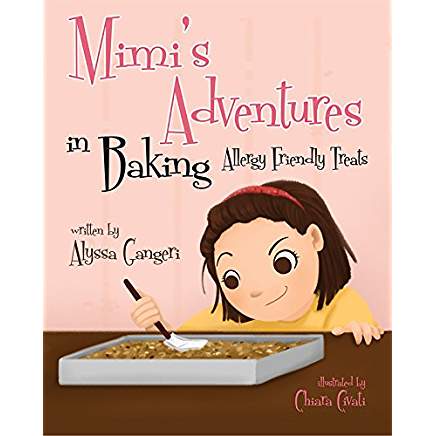 Mimi’s Adventures in Baking Allergy Friendly Treats by Alyssa Gangeri; illustrated by Chiara Civati; published by Mascot Books, 2015
Mimi’s Adventures in Baking Allergy Friendly Treats by Alyssa Gangeri; illustrated by Chiara Civati; published by Mascot Books, 2015
(Ages 4 -8)
This is the perfect book for aspiring chefs. Mimi is a little girl who loves to cook. She is planning on making her friend, Bobby, something special for his birthday, but is devastated when she discovers he has a gluten, milk, peanut, and an egg allergy. She brainstorms with her grandmother and comes up with the perfect solution. She can make homemade granola bars with oats, rice cereal, and dried fruit. Once they confirm with Bobby’s mom that the ingredients are safe for him, Mimi and her grandmother measure out the ingredients in a way that would be easy for children to follow along if they wanted to cook the granola bars with Mimi. I even learned a new cooking trick from Mimi. From now on, I am going to spray my measuring cup with non-stick cooking spray when using honey, so that it doesn’t stick to the cup. Mimi brings in her special treat to school and all of the children are excited to try a tasty gluten, nut, and dairy-free snack. The book concludes with the granola bar recipe as well as some tips to try different variations.
Children can learn more than just cooking tips from this great new series. Mimi is an exuberant character with a kind heart. This book is perfect for inspiring children with or without allergies to create their own delicious treats for themselves or others.
Did I miss any of your favorite food allergy books? Let me know and I’ll look into adding them to the list!


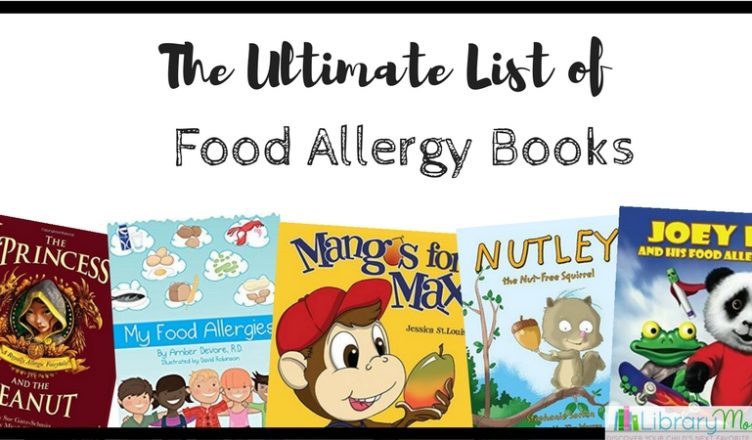





Daniel Tiger has a book about allergies and it’s great!
Thank you so much for reviewing my book and for voting it * BEST BOOK TO EDUCATE CHILDREN WITH ALLERGIES* Amber DeVore
This is great! Thank you so much for doing this. I also love the No Biggie Bunch Series, especially Everyday Cool with Food Allergies.
This is part of an award-winning series that teaches children how to navigate and articulate their emotions.
I Feel…Allergic (I Feel… Children’s Book) https://www.amazon.com/dp/0997425792/ref=cm_sw_r_cp_apa_fP9EAb1B088AC
Thanks for the recommendation! I will definitely check it out.
https://www.amazon.com/Great-UMPKIN-Prince-friendship-created/dp/1539097374
After my sons passing due to Food Allergies I took my grief to creating a more direct understanding of the risks , for older children meant to open the conversations of the serious risks, I did not include pictures since it is not a book a child should read with an adult that might have a child that had bullied or wants to help a child that needs direction of food allergies. A deeper side.. of food allergies not many want to write about.
This is really useful, thanks.
Hello–
Thank you for compiling this list. My teenage daughter, who has lived with multiple life-threatening food allergies her whole life, wrote and illustrated a book for grade-school children with food allergies for her Girl Scout Gold Award project. The purpose of her writing the book was to provide practical tips for those with food allergies and to help children feel supported and to learn how to advocate for themselves. It is available for free at this website https://virginiaheinsen.wixsite.com/daisy
It is also available for purchase on Amazon in Kindle and paperback formats. https://www.amazon.com/dp/1974463745
Thank you!
Alycia
Hi! Great List! We have a new book in 2020 called A Lesson For Every Child – Learning About Food Allergies. Thought you might like it 🙂